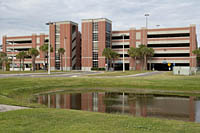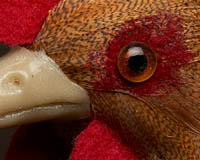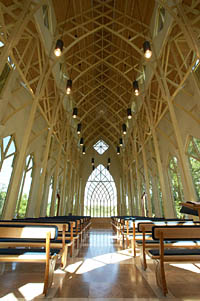Review of the Canon EOS-1Ds Mark II
I use the EOS-1Ds in photography of college gymnastics, portraits,
dance, birds, events, and landscape photography. After using and testing
the 1Ds Mark II for two weeks and using it at the 2005 NCAA Gymnastics
Championship, I think that:
The most
important improvements of the 1Ds Mark II over the original 1Ds are
(Rank order, most important first):
Other reviews have touched on better flash function, tether control, etc. I haven't assessed these yet. I was very happy with flash function on the original 1Ds (except for shooting wedding parties in churches with large window backgrounds in daylight).
Image Detail in Photographs: Does the Mark II offer any clear advantages over the original 1Ds in image quality?
Answer: The Mark II offers slight advantages in some photographic applications.
After studying all of the images in the tests below, I was impressed at what a great job the original EOS-1Ds did with 11 megapixels compared to the newer, 17 megapixel Mark II
| Test Page for Portrait
Application with Mannequin Target with EF 50mm f/1.4 lens Summary Conclusion: The Mark II offers mimimal improvements in working image quality in portrait application over the original 1Ds. |
 |
| Test Page
for Application with Parking Garage Target with EF 24-70mm f/2.8L Summary Conclusion: The Mark II offers noticeable improvement in capturing complex image detail of buildings and landscape over the original 1DS |
 |
| Taxidermy specimen
with EF 300mm f/2.8 L lens Summary Conclusion: There is no 1Ds Mark II advantage here. Autofocus function of the Mark II should be a more important improvement for bird photography (especially in flight). |
 |
Resolution of Subject Detail Measured Using USAF 1951 Pattern and 50% MTF
Method for calculating resolving power is described here using a Edmund Scientific Resolving Power Chart. To measure 50% MTF, 2003 Koren lens test charts are mounted on the Edmund Scientific chart. The method for 50% MTF measurement is here.
In my tests, the EOS-1Ds Mark II has 21.5% better linear resolving power than the original 1Ds. The increased resolving power of line pairs per mm in the USAF 1951 target (from 51 to 62 line pairs per mm) is roughly proportionate to the 23% increase in linear pixel density in the sensor. This is a major imaging improvement. However, you still are not going to be able to perceive this increased resolution as increased sharpness in most photographs since resolution required to perceive most general subjects as sharply imaged falls well below 60 lp/mm. Microcontrast (50% MTF) is also significantly increased with in the 1Ds Mark II compared to the original 1Ds.
Abbreviation: lp/mm = line pair per mm
High Iso Noise
Images produced by the Mark II have noticeably less noise above ISO 400 than the original 1Ds.
| Camera | |||||
| EOS-1Ds | ISO 200 | ISO 400 | ISO 800 | ISO 1250 | |
| EOS-1Ds Mark II | ISO 200 | ISO 400 | ISO 800 | ISO 1250 | ISO 1600 |
File Process and Write Speed
The following are for ISO 800 files written to SanDisk 2 GB Ultra II cards.
| Camera | Time to process and write 10 files to CF card |
File Size | Seconds/file | Mb processed and written per second |
| EOS-1Ds | 70 seconds | 11.4 mb | 7 | 1.6 |
| EOS-1Ds Mark II | 24 seconds | 18 mb | 2.4 | 7.5 |
Autofocus Function is Much Better in the Mark II than in the original EOS-1Ds
The EOS-1Ds Mark II isn't designed for action photography. However, the autofocus function and frame rate allow application of the camera in this area.
I would have been unlikely to get these shots with the original 1Ds because of its poor autofocus function:
Shadow Detail
| No significant improvement in shadow detail was detected in images taken with the EOS-1Ds Mark II. A few examples are presented for illustration purposes. Click here. |  |
Initially posted 25 April 2005; Last revised 01 May 2005.